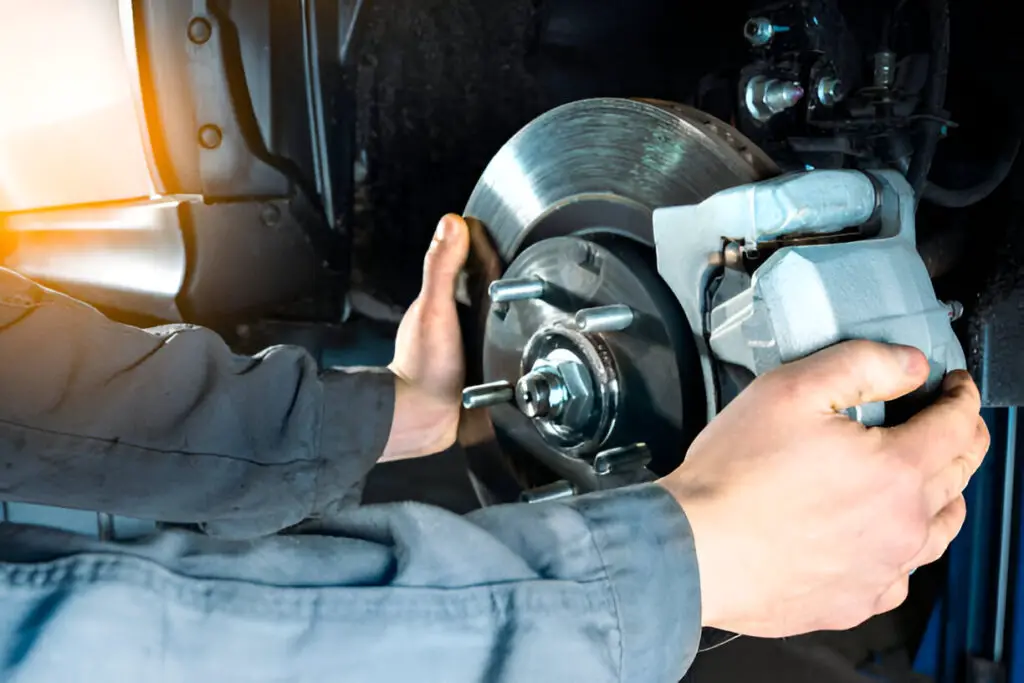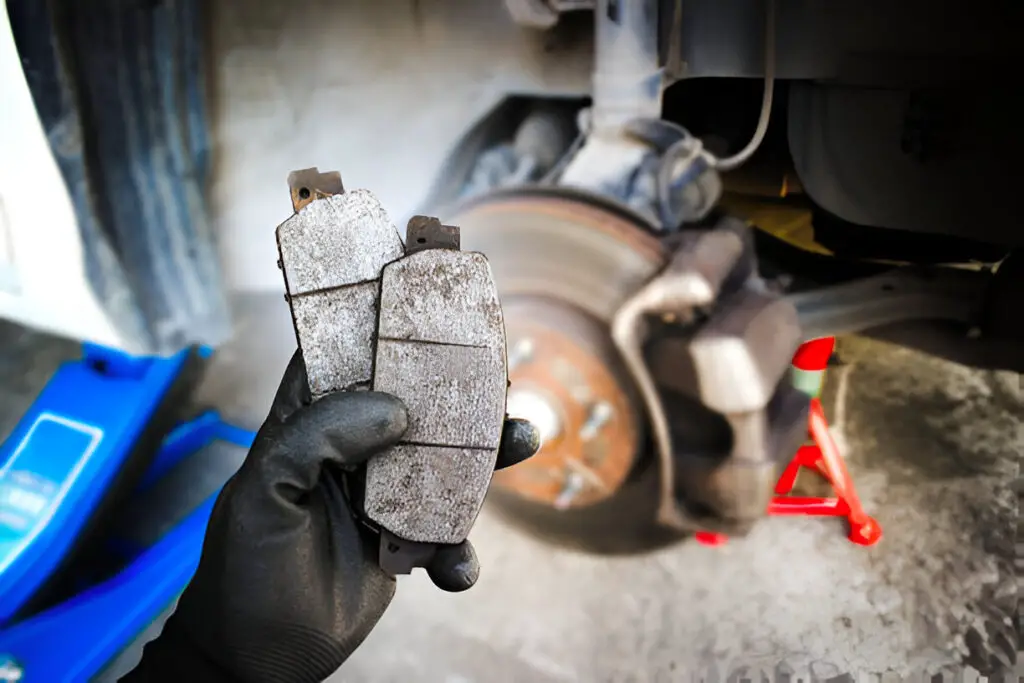Replacing rotors with brake pads ensures even wear and better braking performance. Worn rotors can cause uneven pad wear and reduce stopping power. Doing both together improves safety and extends the life of the brakes.
A Vehicle’s braking system is one of the most important components when it comes to safety, control, and performance. The effectiveness of the brakes depends on the relationship between brake pads and rotors. While many vehicle owners are accustomed to replacing their brake pads as part of routine maintenance, the rotors are often overlooked. However, changing both brake pads and rotors simultaneously offers a variety of benefits, from safety to cost-effectiveness.
In this article, we’ll explore why it’s essential to replace rotors when replacing brake pads, how the two components work together, and the long-term benefits of doing both at the same time.

Contents
Brake Pads and Rotors
To appreciate why replacing rotors along with brake pads is important, it’s essential to understand the function and interdependence of both components.
Brake Pads
Brake pads are the parts of the braking system that make direct contact with the rotors to stop or slow down the vehicle. When you apply the brakes, the brake pads press against the rotor, creating friction that slows down the wheel’s rotation. Over time, this friction wears down the brake pads, making regular replacement necessary.
Brake Rotors
Brake rotors, or discs, are the metal discs attached to your car’s wheel hubs. The brake pads clamp down on the rotors, generating the friction needed to slow the vehicle. Since the rotors endure significant amounts of friction and heat, they too wear down over time, even though it’s less frequent compared to brake pads.
The lifespan of rotors and pads may vary based on driving conditions, driving style, and the type of material used. Typically, brake pads wear out more quickly, but worn or warped rotors can affect the performance of your entire braking system.
Why Replace Rotors When Replacing Brake Pads?
Replacing rotors when you replace brake pads is a critical part of maintaining optimal braking performance and ensuring safety. Here’s why it’s often recommended:
1. Even Wear and Optimal Performance
When new brake pads are installed on worn or uneven rotors, the pads may not make perfect contact with the rotors, leading to uneven wear. This uneven wear can reduce the stopping power of the brakes and lead to premature failure of the new pads.
Rotors develop grooves, cracks, or warping over time due to heat buildup and normal wear and tear. Installing new pads on these imperfect surfaces reduces the braking system’s effectiveness. By replacing both, you ensure that both components wear evenly, maintaining optimal braking performance.
2. Improved Safety
Safety is one of the top reasons to replace rotors when changing brake pads. Rotors with wear, grooves, or warping can cause vibrations and reduced braking efficiency. This may lead to longer stopping distances and less responsive brakes, increasing the risk of accidents.
Replacing both rotors and pads together ensures that your vehicle’s brakes function smoothly, providing consistent and reliable stopping power.
3. Prevention of Rotor Damage
When new brake pads are used with old, worn-out rotors, the pads can wear down more quickly due to improper contact. The new pads may not have a smooth, even surface to grip onto, leading to increased friction in specific spots. Over time, this can cause the rotors to warp or overheat, requiring premature rotor replacement anyway.
By changing both at the same time, you minimize the chance of damaging the rotors in the future, helping to prolong their life and save you money on future repairs.
4. Reduced Brake Noise and Vibration
Old, worn rotors often develop a “lip” around the outer edge due to the wearing down of material over time. When new pads come into contact with these uneven surfaces, they can cause annoying brake noise (squeaking, grinding) or vibration (often felt in the steering wheel). This not only creates an unpleasant driving experience but also indicates that the brakes are not functioning optimally.
Replacing both rotors and pads eliminates these issues by providing smooth surfaces for the pads to contact, resulting in quieter and more stable braking.
5. Extended Brake Pad and Rotor Life
When new brake pads are paired with fresh rotors, the lifespan of both components can be extended. The even contact between the two ensures consistent wear, reducing the likelihood of premature damage to either component.
Using old rotors with new pads can accelerate wear on both parts. Uneven rotor surfaces can grind down new pads faster, leading to earlier replacement. Replacing both components together ensures a longer lifespan for the entire brake system.
6. Cost-Effectiveness
While replacing both rotors and pads may seem like a higher upfront cost, it can save money in the long run. Replacing only the pads while neglecting worn rotors often leads to premature pad wear and the eventual need for rotor replacement anyway, costing you more in labor and parts down the road.
By addressing both components at once, you reduce the need for frequent brake repairs and avoid the extra labor costs associated with doing the job twice.
7. Manufacturer Recommendations
Many vehicle manufacturers recommend replacing rotors along with pads, especially for high-performance or heavy vehicles like trucks and SUVs. In some cases, the rotors cannot be resurfaced (or turned) and must be replaced to maintain the integrity of the brake system.
Following the manufacturer’s guidelines ensures that your brake system performs as designed and meets safety standards. Ignoring these recommendations may void warranties or lead to unsafe driving conditions.

When Should You Replace Rotors and Pads?
The timing for replacing rotors and pads varies depending on driving habits, vehicle type, and the materials used. However, there are some general guidelines and warning signs to help you determine when it’s time for a replacement.
1. Brake Pad Replacement Interval
Brake pads typically need to be replaced every 30,000 to 70,000 miles, depending on the type of pads, driving habits, and vehicle usage. Common signs of worn brake pads include:
- Squealing or grinding noises when braking
- Longer stopping distances
- Brake pedal feeling soft or spongy
2. Rotor Replacement Interval
Rotors generally last longer than brake pads, with replacement intervals around 50,000 to 70,000 miles. However, rotors should be inspected regularly for signs of wear such as:
- Warping or cracks
- Grooves or deep scores on the surface
- Vibrations when braking
- Blue discoloration (a sign of overheating)
The Importance of Regular Brake Inspections
Regular brake inspections are key to ensuring the health of your braking system. Technicians can measure rotor thickness and inspect for any signs of wear or damage. If the rotors are still within their serviceable limits, they may be resurfaced rather than replaced. However, resurfacing has limitations, and severely worn or damaged rotors should always be replaced.
Frequently Asked Questions
Here are some FAQs about replace rotors and brake pads together –
1. Can I Replace Just the Brake Pads Without Replacing the Rotors?
Technically, yes, but it is not recommended. Worn or damaged rotors can significantly reduce the lifespan of your new pads and negatively impact your vehicle’s braking performance. Replacing both ensures safety and longevity.
2. What Are the Signs That My Rotors Need to Be Replaced?
Common signs include vibrations or pulsing in the brake pedal or steering wheel, squeaking or grinding noises, grooves or scores on the rotor surface, and blue discoloration caused by overheating.
3. Is It More Expensive to Replace Both Brake Pads and Rotors at the Same Time?
While the initial cost of replacing both components is higher, it can save you money in the long run by reducing the need for future repairs and ensuring both parts last longer.
4. Can Rotors Be Resurfaced Instead of Replaced?
Yes, rotors can be resurfaced if they are still within the manufacturer’s recommended thickness limits and don’t show signs of severe damage. However, resurfacing is not always an option, and in many cases, it’s safer and more cost-effective to replace them entirely.
Conclusion
Replacing brake pads and rotors together is a smart, cost-effective approach that ensures the safety and longevity of your vehicle’s braking system. While it may seem like an added expense at first, doing both at the same time can prevent premature wear, improve safety, reduce noise and vibration, and provide smoother, more reliable braking. Regular inspections and following manufacturer recommendations for both pads and rotors will keep your vehicle running safely and efficiently for years to come.